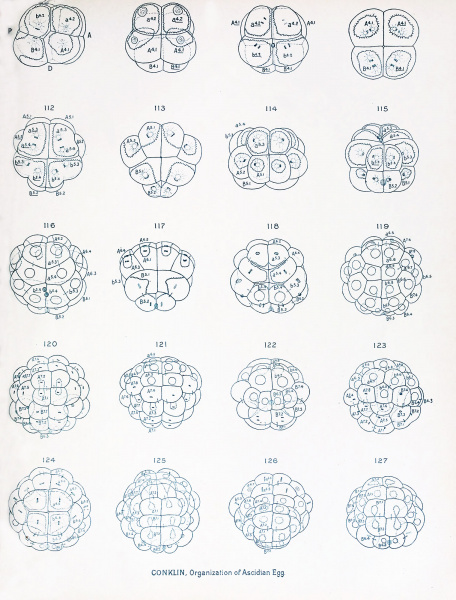File:Conklin 1905 plate08.jpg

Original file (1,521 × 2,000 pixels, file size: 572 KB, MIME type: image/jpeg)
Plate VIII Surface Views of Entire Eggs of Cynthia partita; Eight to Forty-four Cells
Fig. 108. Eight-cell stage ; left side of egg ; showing spindles of third cleavage.
Fig. 109. Anterior view of 8-cell stage, showing cytoplasm most abundant in the animal pole cells, and the yolk largely collected in the anterior cell of the vegetal hemisphere.
Figs. 110, 111,112. Stages in the fourth cleavage; figs. 110 and 112 viewed from the animal pole, fig. Ill from the. vegetal pole.
Fig. 113. Telophase of fourth cleavage, vegetal poje view ; caps of deeply staining protoplasm lie at the hinder borders of the small posterior cells (B 5,2 ).
Figs. 114 and 115. Anterior and posterior views of the 16-cell -stage; fig. 115 showing caps of deeply staining protoplasm at the posterior pole, which later go into the posterior mesenchyme cells (B' 6 , figs. 130, 131).
Figs, 116 and 117. Ventral and dorsal views of a 20-cell stage, showing the cells at the vegetal pole dividing before those at the animal pole.
Fig. 118. Slightly older stage with some of the animal pole cells dividing.
Figs. 119-123. Five views of one and the same egg; fig. 119, ventral; 120, dorsal; 121, anterior; 122, posterior; 123, right side; the latter shows in dotted outlines the great elongation of the cells at the animal pole and the flattened shape of the cells at the vegetal pole ; all the designations of cells in tig. 123 should be underscored ; 44 cells, 16 ectoderm, 10 endoderm, 10 mesoderm, 4 chorda and 4 neural plate cells.
Figs. 124-129. Six different views of one and the same egg in the 44-cell stage showing the divisions of the ectodermal cells and the second cells of the crescent (B 6 ' 4 ) ; when these divisions are completed there will be 62 cells. Fig. 124, ventral; 125, dorsal; 126, anterior; 127, postero-dorsal.
| Historic Disclaimer - information about historic embryology pages |
|---|
| Pages where the terms "Historic" (textbooks, papers, people, recommendations) appear on this site, and sections within pages where this disclaimer appears, indicate that the content and scientific understanding are specific to the time of publication. This means that while some scientific descriptions are still accurate, the terminology and interpretation of the developmental mechanisms reflect the understanding at the time of original publication and those of the preceding periods, these terms, interpretations and recommendations may not reflect our current scientific understanding. (More? Embryology History | Historic Embryology Papers) |
- Conklin Figures: Fig 1-2 | Fig 3-6 | Fig 7-8 | Fig 9-12 | Fig 13-16 | Fig 17-20 | Fig 21-24 | Fig 25-26 | Fig 27-33 | Fig 34-35 | Plate I | Plate II | Plate III | Plate IV | Plate V | Plate VI | Plate VII | Plate VIII | Plate IX | Plate X | Plate XI | Plate XII
Reference
Conklin EG. The Organization and Cell-Lineage of the Ascidian Egg (1905) J. Acad., Nat. Sci. Phila. 13, 1.
Conklin 1905 TOC: I. The Ovarian Egg | II. Maturation and Fertilization | III. Orientation of Egg and Embryo | IV. Cell-Lineage | V. Later Development | VI. Comparisons with A.mphioxus and Amphibia | VII. The Organization of the Egg | Summary | Literature Cited | Explanation of Figures
Cite this page: Hill, M.A. (2024, April 27) Embryology Conklin 1905 plate08.jpg. Retrieved from https://embryology.med.unsw.edu.au/embryology/index.php/File:Conklin_1905_plate08.jpg
- © Dr Mark Hill 2024, UNSW Embryology ISBN: 978 0 7334 2609 4 - UNSW CRICOS Provider Code No. 00098G
File history
Click on a date/time to view the file as it appeared at that time.
| Date/Time | Thumbnail | Dimensions | User | Comment | |
|---|---|---|---|---|---|
| current | 16:19, 19 October 2016 |  | 1,521 × 2,000 (572 KB) | Z8600021 (talk | contribs) | ==Plate VIII== Surface Views of Entire Eggs of Cynthia partita; Eight to Forty-four Cells. Fig. 108. Eight-cell stage ; left side of egg ; showing spindles of third cleavage. Fig. 109. Anterior view of 8-cell stage, showing cytoplasm most abundant... |
You cannot overwrite this file.
File usage
The following 2 pages use this file:
